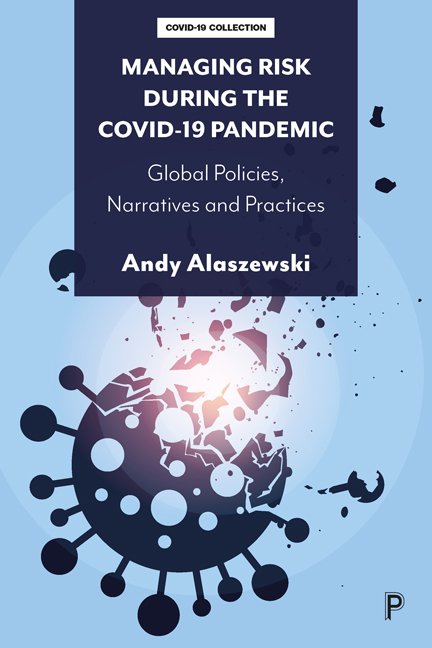Book contents
- Frontmatter
- Dedication
- Contents
- List of tables
- List of abbreviations
- About the author
- Acknowledgements
- Foreword
- Preface
- 1 Introduction: risk as a key feature of late modern societies
- PART I Responding to the challenges of the pandemic
- PART II Mitigating risk through science and technology
- PART III Risk narratives
- References
- Index
1 - Introduction: risk as a key feature of late modern societies
Published online by Cambridge University Press: 20 January 2024
- Frontmatter
- Dedication
- Contents
- List of tables
- List of abbreviations
- About the author
- Acknowledgements
- Foreword
- Preface
- 1 Introduction: risk as a key feature of late modern societies
- PART I Responding to the challenges of the pandemic
- PART II Mitigating risk through science and technology
- PART III Risk narratives
- References
- Index
Summary
Managing uncertainty: dangers and misfortunes
All societies need to manage the uncertainties of the future and account for the misfortunes of the past. In pre-modern societies, religious and supernatural beliefs, whether in sin, magic or witchcraft (Alaszewski, 2015), provided the basis for prediction of the future and allocation of blame for misfortunes. In modern high-income countries with developed health-care systems, such beliefs have been (partially) replaced by the use of rationality, especially risk, making it possible for human actions to be based on reason and evidence. Indeed, for sociologists such as Anthony Giddens (1990, p. 20), rationality is one of the defining characteristics of modernity.
Measuring risk to manage uncertainty
The emergence of risk evaluation as a framework for rational decision making can be traced back to 17th-century commercial and leisure activities. Merchants developed the mechanism of insurance for managing the uncertainties of shipping, with Lloyd's of London being founded by Edward Lloyd in a coffee shop in London in 1686: it still functions as a marketplace in which insurers pool and share risk. Leisure activities such as gambling provided the mathematical underpinning of risk assessment, with statistics and probability developing out of studies of games of chance (Bernstein, 1996). In the 18th century, the study and use of risk was stimulated by the Enlightenment, a social movement committed to the development of secular knowledge that aimed to replace ignorance, superstition and religion with rationality based on science. Risk provided a way of rationally linking the past, present and future: by observing past events, it was possible to calculate the probability of such events occurring in the future, and therefore make better, more rational decisions in the present (Bernstein, 1996, p. 48).
Predicting the future
A key role of risk assessment is to provide a way of reducing uncertainty by predicting the future, especially identifying dangers that can be avoided. This is often seen as a technical exercise based on measuring the probability of outcomes. During the COVID-19 pandemic, a lot of attention was given to measuring or modelling the probability of infection by the virus.
- Type
- Chapter
- Information
- Managing Risk during the COVID-19 PandemicGlobal Policies, Narratives and Practices, pp. 1 - 8Publisher: Bristol University PressPrint publication year: 2023



